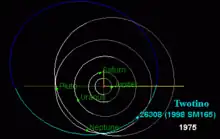 Hubble Space Telescope image of 1998 SM165 and its companion, taken in December 2001 | |
| Discovery[1] | |
|---|---|
| Discovered by | N. Danzl |
| Discovery site | Kitt Peak Obs. |
| Discovery date | 16 September 1998 |
| Designations | |
| (26308) 1998 SM165 | |
| 1998 SM165 | |
| TNO[2] · twotino[3][4][5] Kozai · distant[1] | |
| Orbital characteristics[2] | |
| Epoch 4 September 2017 (JD 2458000.5) | |
| Uncertainty parameter 2 | |
| Observation arc | 32.26 yr (11,784 days) |
| Earliest precovery date | 12 October 1982 |
| Aphelion | 64.968 AU |
| Perihelion | 29.866 AU |
| 47.417 AU | |
| Eccentricity | 0.3701 |
| 326.52 yr (119,261 days) | |
| 47.484° | |
| 0° 0m 10.8s / day | |
| Inclination | 13.521° |
| 183.21° | |
| 130.22° | |
| Known satellites | S/2001 (26308) 1[5] (96±12 km in diameter)[6] |
| Physical characteristics | |
| Dimensions | 268±28 km (derived)[5] 287±36 km[6] |
| Mass | (6.87±0.018)×1018 kg[5] |
Mean density | 0.51+0.29 −0.14 g/cm3[6] |
| 8.40±0.05 h[6] | |
| 0.07±0.02[6] | |
| 5.7[2] | |
(26308) 1998 SM165 is a resonant trans-Neptunian object and binary system from the Kuiper belt in the outermost regions of the Solar System. It was discovered on 16 September 1998, by American astronomer Nichole Danzl at the Kitt Peak National Observatory in Arizona.[1] It is classified as a twotino and measures approximately 280 kilometers in diameter. Its minor-planet moon was discovered in 2001.[5]
Twotino
1998 SM165 has a semi-major axis (average distance from the Sun) near the edge of the classical belt. The Deep Ecliptic Survey (DES) list this trans-Neptunian object as a twotino that stays in a 1:2 orbital resonance with the planet Neptune (for every one orbit that a twotino makes, Neptune orbits twice).[3][4]
Physical characteristics
The observations with the infrared Spitzer Space Telescope combined with the orbits established using the Hubble Space Telescope allow the estimation of the density, assuming the components of equal albedo.
The resulting estimate of 0.51+0.29
−0.14 g/cm3[6]
is similar to the density of the binary plutino 47171 Lempo (0.3–0.8 g/cm3[7]) and Saturn's moon Hyperion (0.567±0.102 g/cm3[8])
Such a low density is indicative of a highly porous composition dominated by ice.[6]
1998 SM165 is fairly red, with a color comparable to 79360 Sila–Nunam.
Satellite
On 22 December 2001, a minor-planet moon, provisionally designated S/2001 (26308) 1, was discovered by American astronomer Michael Brown and Chad Trujillo using the Hubble Space Telescope.[5] The discovery was announced in January 2002. The satellite measures approximately 96 ± 12 km (59.7 ± 7.5 mi) in diameter and orbits its primary at a distance of 11,310 ± 110 km (7,028 ± 68 mi). Assuming a circular orbit, this takes 130.1±1 days to complete one orbit.[5]
Numbering and naming
This minor planet was numbered by the Minor Planet Center on 5 July 2001.[9] As of 2018, it has not been named.[1]
References
- 1 2 3 4 "26308 (1998 SM165)". Minor Planet Center. Retrieved 11 October 2017.
- 1 2 3 "JPL Small-Body Database Browser: 26308 (1998 SM165)" (2015-01-16 last obs.). Jet Propulsion Laboratory. Retrieved 11 October 2017.
- 1 2 "MPEC 2009-J35 :Distant Minor Planets (2009 MAY 29.0 TT)". Minor Planet Center. 8 May 2009. Retrieved 22 August 2016.
- 1 2 Marc W. Buie. "Orbit Fit and Astrometric record for 26308" (2007/09/11 using 73 observations). SwRI (Space Science Department). Retrieved 12 May 2009.
- 1 2 3 4 5 6 7 "(26308) 1998 SM165 and S/2001 (26308) 1". johnstonsarchive. 21 September 2014. Retrieved 11 October 2017.
- 1 2 3 4 5 6 7 Spencer, J.; Stansberry, J.; Grundy, W.; Noll, K. (September 2006). "A Low Density for Binary Kuiper Belt Object (26308) 1998 SM165". Bulletin of the American Astronomical Society. American Astronomical Society. 38: 546. Bibcode:2006DPS....38.3401S.
- ↑ Stansberry, J.; Grundy, W.; Margot, J-L.; Cruikshank, D.; Emery, J.; Rieke, G.; Trilling, D. (May 2006). "The Albedo, Size, and Density of Binary Kuiper Belt Object (47171) 1999 TC36". The Astrophysical Journal. 643 (1): 556–566. arXiv:astro-ph/0602316. Bibcode:2006ApJ...643..556S. doi:10.1086/502674. S2CID 18146599.
- ↑ Jacobson, R. A.; Antreasian, P. G.; Bordi, J. J.; Criddle, K. E.; Ionasescu, R.; Jones, J. B.; Mackenzie, R. A.; Meek, M. C.; Parcher, D.; Pelletier, F. J.; Owen, W. M. Jr.; Roth, D. C.; Roundhill, I. M.; Stauch, J. R. (December 2006). "The Gravity Field of the Saturnian System from Satellite Observations and Spacecraft Tracking Data". The Astronomical Journal. 132 (6): 2520–2526. Bibcode:2006AJ....132.2520J. doi:10.1086/508812.
- ↑ "MPC/MPO/MPS Archive". Minor Planet Center. Retrieved 24 February 2018.
External links
- List Of Transneptunian Objects, Minor Planet Center
- (26308) 1998 SM165 at AstDyS-2, Asteroids—Dynamic Site
- (26308) 1998 SM165 at the JPL Small-Body Database
